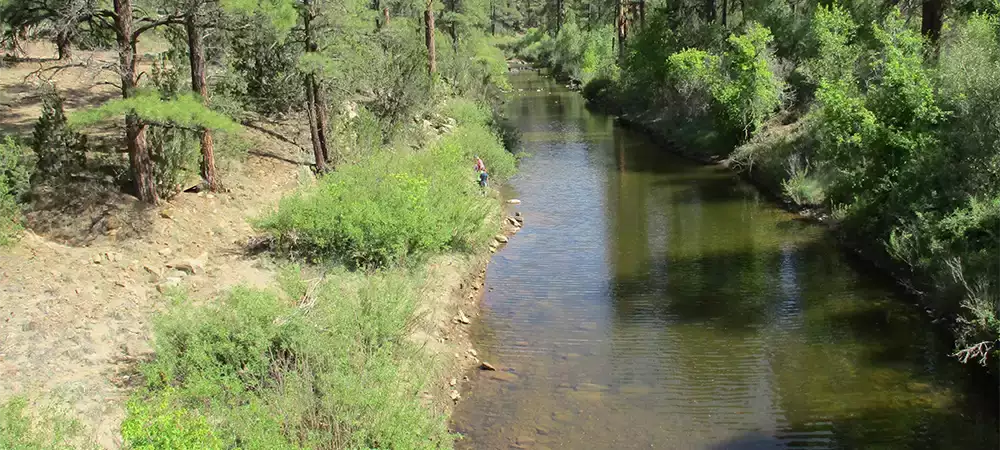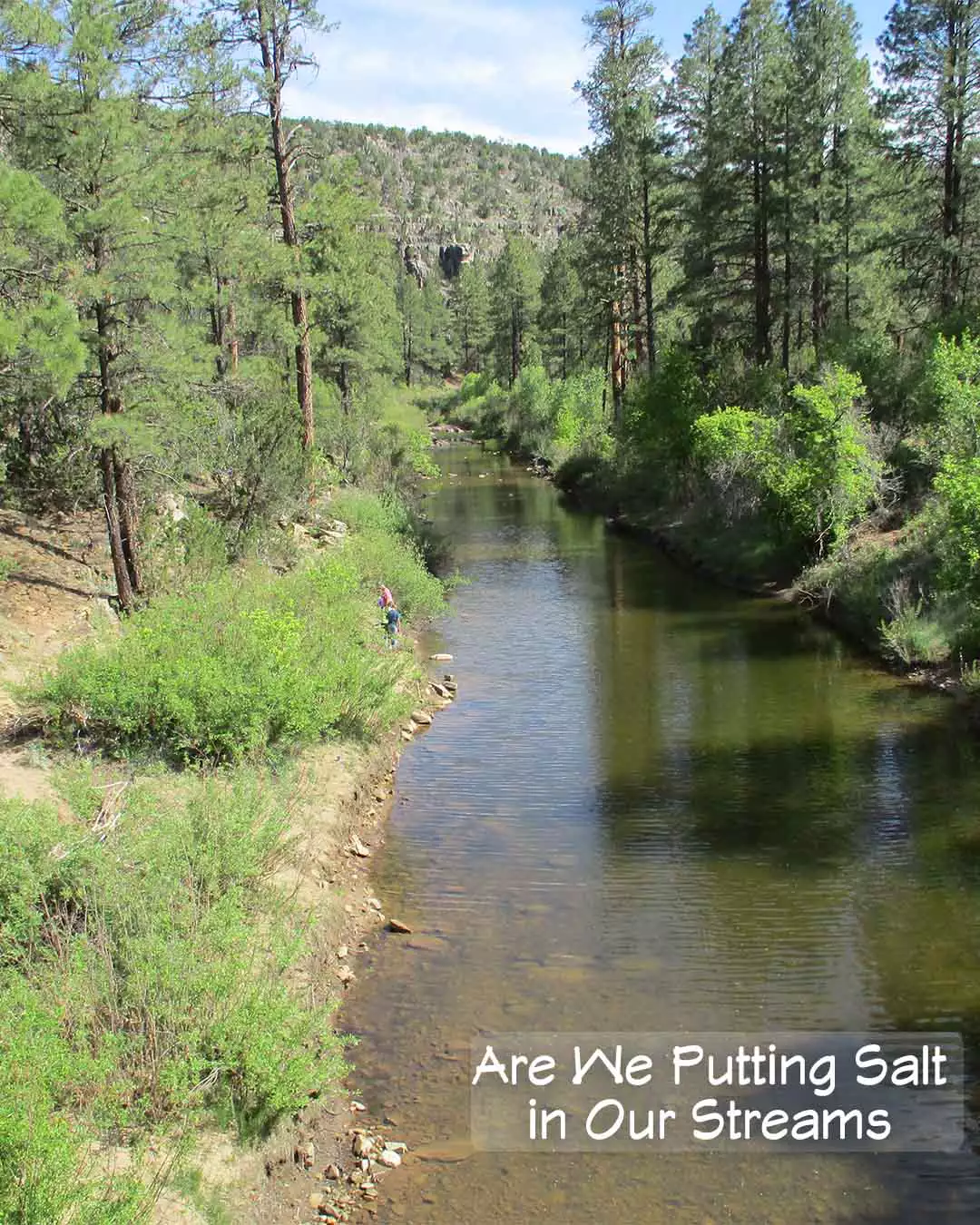

Sodium Chloride vs. Potassium Chloride
Should we be concerned about the Salt Discharge from the Water Softener getting into the Rivers and Streams?
The Salt from your Water Softener during a Regeneration Cycle goes down the Drain then into the City Waste Water Treatment Plant. It is estimated that more than 50% of the Sodium Chloride released by Water Treatment Plants is coming from Home Water Softeners.
Removing the Salt from the Water at a Municipal Treatment Plant is not Cost Effective and most are not Designed to remove the Salt.
Chloride is a Permanent Pollutant that is Toxic to Fish and other Aquatic Life. 1 Teaspoon of Salt is considered enough to Pollute 5 Gallons of Water.
Water Softeners Sodium Chloride may Not be the Major Contaminant to our Waterways & Streams but it is a Growing Problem that we can easily Address.
The Major Portion of Sodium Chloride in our Lakes and Streams is from Road Salt. In some States Road Salt is still being used to Melt Icy Patches of Ice.
Sodium Chloride
The Chemical Name for Salt. In Our Body the Sodium and Potassium are Electrolytes that maintain the Fluid and Blood Volume. Sodium Chloride is the Salt in the Salinity of Seawater.
Salt and Sodium are often used as meaning the same thing but they are different in their meaning,
Rock Salt is Not the same as Water Softener Salt. Rock Salt is not Purified and the Impurities may Harm your Water Softener.
Potassium Chloride
This also a Salt but a More Friendly Salt than Sodium. Potassium is a nutrient that helps Plants Grow thus is more Environmentally Friendly.
There is always an Argument Pro and Con, the Pro for Potassium Chloride is that Potassium is more environmentally friendly. The con is costs around 3 times as much as Salt Pellets and it is less Efficient.
At the Homeowner Level
We could start using Potassium Chloride as the 1st Step towards reducing the amount of Sodium Chloride in the Environment.
We can Upgrade to a more efficient Model of Water Softener. The Newer Units are called On Demand Water Softeners. These Units Do Not use a Timer to activate the Regeneration Cycle. The Newer On Demand Units reduce the amount of Salt Discharge by up to 60%.
It may seem like a Minor Detail but Some Water Softeners are Undersized in an attempt to save Money. Undersized Units require More Regeneration than Proper Sized Units therefore using more Sodium Chloride or Potassium Chloride.
At the Municipal Level
Some States and Local Municipalities are Instituting Restrictions or Some Sort of Ban on Salt ion Exchange Water Softeners. The remaining States that are using Sodium Chloride on the Highways in Winter can reduce the amount or alternate between some other Product that could achieve the same result.
Maintenance
Can you just keep adding Salt or do You need to have the Softener Checked every Year? Manufacturers suggest a Maintenance Schedule in their Manuals, for your Softener. If you no longer have the Manual, do a Search for Your Model of Softener's Maintenance requirements.
Proper Settings and Sizing
You need to know the Incoming Water Hardness Levels. You will need to Contact your Water Supplier to Update the Setting of your Waters Hardness Level. If you are Upgrading be sure to match the Size of the Unit based upon your Past Water Usage. Refer to our Article Water Softener Efficiency and Sizing. (see the Link below)
Can using a Water Softener Destroy Copper Pipes
Yes, Softened and Heated Water tends to Leach Metals from Water Pipes. Copper Pipes and Lead used to Bond the Joints are especially Vulnerable to Softened and Heated Water. Newer Homes use Pex Piping which is not a problem with Softened Water.
Can Dirty Water affect the Process of Water Softeners
Water Cloudiness or Fouling could be caused by Solids like Dirt or maybe Exposure of the Iron & Manganese. Chlorine or Air in the Line can also make the Water appear Cloudy. This could prevent the Process in the Beads to Perform properly.
The Water should be Disinfected before it gets to the Inlet to Your Home. Bacteria could Potentially grow on Surfaces in the ion Exchange Water Softener.
Could the Salt in the Water be Unhealthy
Will the added Salt in the Water be a concern for Folks that are on a Restricted Salt Diets.
Yes. but It's not much, about 30g, this is considered Healthy. However, a Reverse Osmosis System will remove that amount of Salt. See the Link below to Our Reverse Osmosis Post. Reverse Osmosis will remove the Salt.
Do Water Softeners Cause Scaling
Water Softeners will Not Cause Scaling in your Pipes. Scaling is mostly caused by Hard Water that has Large amounts of Calcium and Magnesium.
Is Water a Universal Solvent
Water can Dissolve more Substances than any other Liquid. Yes, Water is a Universal Solvent.
Comment Below
Internal Links
Internal Links
Like this Article, you can give us a Thumbs just click on the Icon. It's anonymous and we will Thank You.

“Study Nature, love Nature, stay close to Nature. It will never fail you”
Frank Lloyd Wright
© Copyright 2023 YPRemodel.com. All rights Reserved. This material may not be Published, Broadcast, Rewritten or Redistributed without written Permission.
